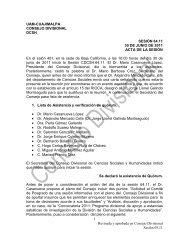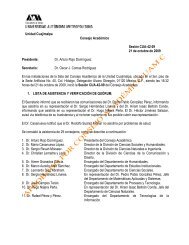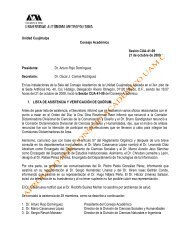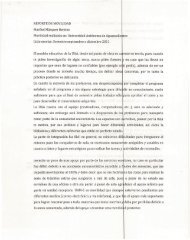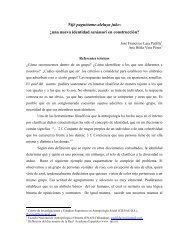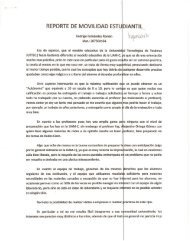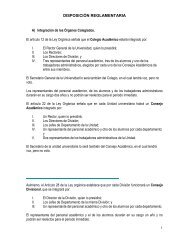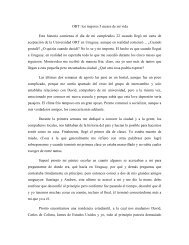A novel 8.7 kDa protease inhibitor from chan seeds (Hyptis ... - UAM
A novel 8.7 kDa protease inhibitor from chan seeds (Hyptis ... - UAM
A novel 8.7 kDa protease inhibitor from chan seeds (Hyptis ... - UAM
Create successful ePaper yourself
Turn your PDF publications into a flip-book with our unique Google optimized e-Paper software.
Comparative Biochemistry and Physiology Part B 138 (2004) 81–89<br />
A <strong>novel</strong> <strong>8.7</strong> <strong>kDa</strong> <strong>protease</strong> <strong>inhibitor</strong> <strong>from</strong> <strong>chan</strong> <strong>seeds</strong> (<strong>Hyptis</strong><br />
suaveolens L.) inhibits <strong>protease</strong>s <strong>from</strong> the larger grain borer<br />
Prostephanus truncatus (Coleoptera: Bostrichidae)<br />
a a b<br />
Cesar Aguirre , Silvia Valdes-Rodrıguez ´ ´ , Guillermo Mendoza-Hernandez ´ ,<br />
c a,<br />
Arturo Rojo-Domınguez ´ , Alejandro Blanco-Labra *<br />
a<br />
Departamento de Biotecnologıa ´ y Bioquımica, ´<br />
Centro de Investigacion ´ y de Estudios Avanzados (Cinvestav) Unidad Irapuato. Km 9.6 Libramiento Norte Carretera Irapuato-Leon, ´<br />
C.P. 36500 Irapuato Gto, Mexico<br />
b<br />
Departamento de Bioquımica, ´ Facultad de Medicina, Universidad Nacional Autonoma ´ de Mexico, ´ Apartado Postal 70-159,<br />
Mexico D.F. 04510, Mexico<br />
c<br />
Departamento de Quımica, ´ Universidad Autonoma ´ Metropolitana-Iztapalapa, San Rafael Atlixco 186, Col. Vicentina,<br />
Iztapalapa 09340, Mexico<br />
Received 28 October 2003; received in revised form 12 February 2004; accepted 28 February 2004<br />
Abstract<br />
A <strong>novel</strong> trypsin <strong>inhibitor</strong> purified <strong>from</strong> <strong>chan</strong> <strong>seeds</strong> (<strong>Hyptis</strong> suaveolens, Lamiaceae) was purified and characterized. Its<br />
apparent molecular mass was 8700 Da with an isoelectric point of 3.4. Its N-terminal sequence showed a high content<br />
of acidic amino acids (seven out of 18 residues). Its <strong>inhibitor</strong>y activity was potent toward all trypsin-like <strong>protease</strong>s<br />
extracted <strong>from</strong> the gut of the insect Prostephanus truncatus (Coleoptera: Bostrichidae), a very important pest of maize.<br />
This activity was highly specific, because among <strong>protease</strong>s <strong>from</strong> seven different insects, only those <strong>from</strong> P. truncatus<br />
and Manduca sexta (Lepidoptera: Sphingidae) were inhibited. This <strong>inhibitor</strong> has potential to enhance the defense<br />
me<strong>chan</strong>ism of maize against the attack of P. truncatus.<br />
2004 Elsevier Inc. All rights reserved.<br />
Keywords: Chan; <strong>Hyptis</strong> suaveolens; Larger grain borer; Maize; Manduca sexta; Plant defense me<strong>chan</strong>isms; Prostephanus truncatus;<br />
Proteases; Protease <strong>inhibitor</strong><br />
1. Introduction<br />
A wild plant known as Chan or Colima’s Chia<br />
(<strong>Hyptis</strong> suaveolens L.) has played an important<br />
role as a source of food and medicinal plant for<br />
the pre-Hispanic tribes that inhabited the tropical<br />
and subtropical regions of the Central-West part of<br />
Mexico (Martınez, ´ 1959; Vergara-Santana and<br />
*Corresponding author. Tel.: q52-462-6239600; fax: q52-<br />
462-6245996.<br />
E-mail address: ablanco@ira.cinvestav.mx<br />
(A. Blanco-Labra).<br />
Bravo-Magana, ˜ 1992). From a reference to Chan<br />
in the Mendocino codex (Kingsborough, 1964), it<br />
was established that these <strong>seeds</strong> were cultivated<br />
and highly appreciated since the pre-Hispanic cultures,<br />
most probably due to their high resistance<br />
to insect and fungal attack, as well as for their<br />
high nutritional and medicinal characteristics (Hernandez,<br />
´ 1959; Kingsborough, 1964; Weber et al.,<br />
1991; Singh and Upadhyay, 1993; Fatope et al.,<br />
1995).<br />
Protease <strong>inhibitor</strong>s, broadly distributed in nature,<br />
are proteins that form very stable complexes with<br />
1096-4959/04/$ - see front matter 2004 Elsevier Inc. All rights reserved.<br />
doi:10.1016/j.cbpc.2004.02.011
82 C. Aguirre et al. / Comparative Biochemistry and Physiology Part B 138 (2004) 81–89<br />
proteolytic enzymes. Most of these <strong>inhibitor</strong>s are<br />
small molecules with relative molecular masses<br />
ranging <strong>from</strong> 5 to 25 <strong>kDa</strong>, with compact structures<br />
and in many cases with a high content of disulfide<br />
bridges, characteristics that might contribute to<br />
their high thermal stability (Singh and Rao, 2002).<br />
Protease <strong>inhibitor</strong>s participate in the defense<br />
against the attack of insects, documented in part<br />
by in vitro assays indicating that these proteins are<br />
responsible for the inhibition of a <strong>protease</strong> activity<br />
in the insect gut. Bioassays using purified proteins<br />
have also shown detrimental effects on insect<br />
growth and some of them also have insecticidal<br />
activities (Gatehouse and Gatehouse, 1998;<br />
Fabrick et al., 2002; Alfonso-Rubi et al., 2003).<br />
Different genes coding for <strong>protease</strong> <strong>inhibitor</strong>s have<br />
been expressed in different plants, producing an<br />
increase in their resistance to the attack of some<br />
specific insects (Estruch et al., 1997; Altpeter et<br />
al., 1999; Fabrick et al., 2002). Mustard trypsin<br />
<strong>inhibitor</strong> 2 (MTI-2) expressed in transgenic tobacco<br />
did not affect the development of Spodoptera<br />
littoralis larvae but had a significant negative<br />
effect on their fertility (De Leo and Gallerani,<br />
2002).<br />
The larger grain borer (Prostephanus truncatus)<br />
was accidentally introduced into Africa in the late<br />
1970s <strong>from</strong> its area of origin in Central America,<br />
where it had long been recognized as an important<br />
pest of stored maize. The beetle appeared first in<br />
East and then West Africa (Dunstan and Magazini,<br />
1981; Krall, 1984) and later spread to at least 15<br />
countries (Bell et al., 1999; Farrell, 2000). It has<br />
recently been recognized as the most destructive<br />
pest of farm-stored maize and dry cassava in Africa<br />
(Boxall, 2002).<br />
Losses in maize due to P. truncatus were consistently<br />
higher than those produced by indigenous<br />
pest species, such as Sitophilus spp (5–10%,<br />
compared to 15–45% for P. truncatus) in Ghana.<br />
According to Boxall (2002), this situation threatens<br />
not only this important cash crop but also the<br />
food security of vulnerable rural products.<br />
The goal of the present work was to purify and<br />
characterize a <strong>novel</strong> <strong>protease</strong> <strong>inhibitor</strong> <strong>from</strong> <strong>chan</strong><br />
<strong>seeds</strong>, with potential for the control of the insect<br />
P. truncatus.<br />
2. Materials and methods<br />
Chan (H. suaveolens) <strong>seeds</strong> were provided by<br />
Dr Martha Vergara-Santana (Herbarium, University<br />
of Colima, Mexico). Insects (P. truncatus)<br />
were provided by the insectary at Cinvestav-Irapuato,<br />
Mexico. Bovine pancreas trypsin (type I;<br />
EC 3.4.21.4), chymotrypsin (EC 3.4.21.1), papain<br />
(EC 3.4.22.2), elastase (EC 3.4.21.36)and N a-<br />
benzoyl-L-arginine ethyl ester (BAEE), were <strong>from</strong><br />
Sigma-Aldrich (St. Louis, MO, USA). Sephadex<br />
G-75 and molecular mass markers were <strong>from</strong><br />
<br />
Pharmacia (Uppsala, Sweden). Econo-Pac High<br />
Q cartridge was <strong>from</strong> Bio-Rad (Hercules, CA,<br />
USA). All chemicals were analytical grade. Deionized<br />
water was used throughout.<br />
2.1. Inhibitor purification<br />
2.1.1. Extraction<br />
Chan flour was defatted with a mixture of<br />
chloroform:methanol (2:1 vyv) in a 4:1 wyv ratio.<br />
Extraction of the <strong>inhibitor</strong> was carried out by<br />
stirring a suspension of Chan flour in water (1:5<br />
wyv) for4hat48C. Insoluble materials were<br />
removed by centrifugation at 10 000=g for 60<br />
min. The crude extract was precipitated by adding<br />
ammonium sulfate <strong>from</strong> 30 to 70% saturation. The<br />
precipitate was separated and dialyzed against<br />
water. The dialyzed solution was used for further<br />
purification.<br />
2.1.2. Gel filtration<br />
A concentrated solution of H. suaveolens trypsin<br />
<strong>inhibitor</strong> (HSTI) after dialysis, was passed through<br />
a Sephadex G-75 gel filtration column (2.25=167<br />
cm), equilibrated with 0.02 M ammonium bicarbonate,<br />
pH 7.8. It was eluted using a flow rate of<br />
0.3 mlymin, collecting 4 ml fractions. Fractions<br />
with <strong>inhibitor</strong>y activities (42–52, Fig. 2) were<br />
pooled and concentrated by lyophilization.<br />
2.1.3. Ion-ex<strong>chan</strong>ge chromatography<br />
Ion-ex<strong>chan</strong>ge chromatography was carried out<br />
at RT (approx. 25 8C). A concentrated <strong>inhibitor</strong><br />
sample <strong>from</strong> the pooled gel filtration samples (2<br />
<br />
ml) was loaded into an Econo-Pac high Q cartridge<br />
column (1=5 cm) equilibrated with 0.01<br />
M Tris–HCl pH 8.0. After washing the column<br />
with 30 ml of buffer solution, elution was carried<br />
out with a linear gradient of 0.0–0.4 M NaCl in<br />
0.01 M Tris–HCl buffer (pH 8.0), with a flow<br />
rate of 1 mlymin, collecting 2 ml fractions. Fractions<br />
with trypsin <strong>inhibitor</strong>y activities (67–81, Fig.<br />
3) were pooled, dialyzed against deionized water<br />
and lyophilized.
C. Aguirre et al. / Comparative Biochemistry and Physiology Part B 138 (2004) 81–89<br />
83<br />
2.1.4. Reverse-phase HPLC<br />
A concentrated <strong>inhibitor</strong> sample <strong>from</strong> the pooled<br />
ion-ex<strong>chan</strong>ge chromatography (100 ml) after dialysis,<br />
was separated by a reverse-phase Vydac C 18<br />
HPLC column (22.5 mm ID=250 mm length and<br />
10 mm particle size), with a gradient of 0–80%<br />
(by vol.) acetonitrile in water (Fig. 4). Peak<br />
fractions were frozen and lyophilized to remove<br />
the acetonitrile. Fractions were evaluated by electrophoresis<br />
(Fig. 5), and those containing a single<br />
band were used for protein characterization.<br />
2.1.5. Protein determination<br />
Protein concentration was determined by the<br />
Bradford protein assay (Bradford, 1976). Bovine<br />
serum albumin (BSA) was used as standard.<br />
2.2. Characterization<br />
2.2.1. Molecular mass determination<br />
Molecular mass was determined by sodium<br />
dodecyl sulfate- polyacrylamide gel electrophoresis<br />
(SDS-PAGE) using a 13% separating gel, following<br />
procedure Schagger ¨ and von Jagow (1987).<br />
Globin (16 949 Da), Globin IqII (14 404 Da),<br />
Globin IqIII (10 700 Da), Globin I (8159 Da),<br />
Globin II (6214 Da) and Globin III (2512 Da),<br />
were used as molecular mass markers.<br />
2.2.2. Isoelectric point<br />
Isoelectric focusing (IEF) was performed at RT<br />
in a Pharmacia LKB electrophoresis PhastSystem<br />
using a Phastgel 3-9.<br />
2.2.3. Stability<br />
Stability of the <strong>inhibitor</strong> was evaluated by<br />
exposing the sample for 60 min at temperatures<br />
ranging <strong>from</strong> 4 to 94 8C, at five different pH<br />
values, <strong>from</strong> pH 3 to 10.7. The <strong>inhibitor</strong> (0.02<br />
mg) was dissolved in 1 ml of the appropriate<br />
buffer (0.025 M) solution. Buffers included citrate<br />
solution pH 3 and pH 5, phosphate solution pH 7<br />
and carbonate solutions pH 9.2 and pH 10.7. For<br />
residual trypsin <strong>inhibitor</strong>y activity at the end of<br />
the thermal treatment, the solution was cooled in<br />
an ice bath and the activity determined at RT in<br />
0.15 M Tris–HCl, CaCl 2, 0.05 M, pH 8.1 buffer<br />
solution, using bovine trypsin and BAEE as substrate<br />
to monitor the activity (Schwertz and Takenaka,<br />
1955).<br />
2.2.4. N-terminal sequence determination<br />
The N-terminal sequence of the purified protein<br />
was determined using repeated cycles of Edman<br />
degradation. Analysis was performed in an automatic<br />
sequencer (Beckman–Porton Protein<br />
sequencer, model LF 3000).<br />
2.2.5. Circular dichroism spectroscopy analysis<br />
This analysis was performed using a JASCO J-<br />
715 spectropolarimeter calibrated with (q)10-<br />
camphorsulfonic acid (Hennessey and Johnson,<br />
1982). Samples were dialyzed overnight against<br />
water, and spectra were obtained in a quartz cell<br />
of 1 mm pathlength at a protein concentration of<br />
0.1 mgyml. Circular dichroism spectra were deconvoluted<br />
in the DichroWeb server (Lobley et al.,<br />
2002) with four different methods: k2d, Selcon,<br />
Contin and CDSSTR (Andrade et al., 1993; Sreerama<br />
and Woody, 2000). The former is a neural<br />
network algorithm that interprets the region <strong>from</strong><br />
200 to 240 nm of CD spectra in terms of three<br />
different secondary structure contributors: a-helix,<br />
b-strand and others. The latter methods use a<br />
broader region of the spectra (185–240 nm) and<br />
estimates the a-helix, b-strand, turn and irregular<br />
fractions of secondary structure; also, they can use<br />
different sets of CD spectra as reference. In this<br />
work we used sets 3, 4, 6 and 7 <strong>from</strong> the<br />
DichroWeb server and results were averaged and<br />
are presented in Table 3.<br />
2.3. Extraction of larval enzymes<br />
Proteolytic enzymes were extracted <strong>from</strong> third<br />
instar larvae for the insects: P. truncatus (Horn)<br />
(Coleoptera: Bostrichidae), Sitotroga cerealella<br />
(Olivier) (Lepidoptera: Gelechiidae), Tribolium<br />
castaneum (Herbst) (Coleoptera: Tenebrionidae),<br />
Callosobruchus maculatus (Fabricius) (Coleoptera:<br />
Bruchidae), Acanthoscelides obtectus (Say)<br />
(Coleoptera: Bruchidae) and Sitophilus zeamais<br />
(Motschulsky) (Coleoptera: Curculionidae). For<br />
Manduca sexta (Linnaeus) (Lepidoptera: Sphingidae),<br />
fifth instar larvae were used. The extraction<br />
was done according to the method described by<br />
Valdes-Rodrıguez ´ ´ et al. (1993), using crude<br />
extracts.<br />
2.3.1. Zymograms<br />
For the assay of <strong>protease</strong> <strong>inhibitor</strong> activity in<br />
polyacrylamide gel electrophoresis, we followed<br />
the method described by Garcıa-Carreno ´ ˜ et al.
84 C. Aguirre et al. / Comparative Biochemistry and Physiology Part B 138 (2004) 81–89<br />
Fig. 1. Zymogram of the crude extract in native PAGE. A:<br />
Crude extract of <strong>chan</strong> (H. suaveolens) <strong>seeds</strong>, B: Amaranth<br />
trypsin <strong>inhibitor</strong> used as positive control.<br />
(1993) using casein as substrate. For <strong>protease</strong><br />
activity on X-ray film, we used the method<br />
described by Machhandra and Manavendra (1994).<br />
2.3.2. Protease <strong>inhibitor</strong> activity determination<br />
Inhibitor activity against trypsin and trypsin-like<br />
enzymes of P. truncatus was assayed by monitoring<br />
the initial rate of hydrolysis of BAEE at 253<br />
nm in 0.15 M Tris–HCl, CaCl2<br />
0.05 M, pH 8.1<br />
after 3 min of incubation (Schwertz and Takenaka,<br />
1955). Inhibitor activity against <strong>protease</strong>s of T.<br />
castaneum, C. maculatus, A. obtectus and S. zeamais<br />
was assayed by monitoring the hydrolysis of<br />
casein at 280 nm in 0.04 M succinic acid, 0.06 M<br />
NaCl, pH 6.5 after 3 min of incubation (Kakade<br />
et al., 1969). At pH 2.5, it was assayed by<br />
monitoring the hydrolysis of hemoglobin at 280<br />
nm in 0.2 M citric acid, 0.1 M NaCl, after 3 min<br />
of incubation (Lenney, 1975). One unit of proteolytic<br />
activity was defined as an increase in 0.01<br />
absorbance units under the assay conditions<br />
described. Inhibitor activity was defined as the<br />
difference between the proteolytic activity measured<br />
in the absence and in the presence of the<br />
<strong>inhibitor</strong>. Inhibition Units (IU) were calculated as<br />
follows:<br />
IUymls<br />
Enzyme ODyŽ EnzymeqInhibitor.<br />
OD<br />
0.01=Sample<br />
Ž ml.<br />
Samples of the <strong>inhibitor</strong> obtained <strong>from</strong> the<br />
purification procedure were screened for <strong>inhibitor</strong>y<br />
Fig. 2. Gel filtration chromatography after (NH ) SO precip-<br />
4 2 4<br />
itation. Fractions were monitored for absorbance at 220 nm<br />
(line) and trypsin <strong>inhibitor</strong> activity (diamonds).<br />
activity against trypsin, chymotrypsin, papain and<br />
elastase.<br />
3. Results<br />
3.1. Purification<br />
When subjected to electrophoresis and stained<br />
for <strong>inhibitor</strong>y activity, crude extract of Chan flour<br />
contained a single protein <strong>inhibitor</strong> (Fig. 1). Proteins<br />
were precipitated and separated by gel filtration<br />
(Fig. 2). The peak containing the <strong>inhibitor</strong>y<br />
activity was collected and resolved by ion<br />
Fig. 3. Ion ex<strong>chan</strong>ge chromatography of the fraction obtained<br />
after gel filtration. Fractions were monitored for absorbance at<br />
220 nm (line), trypsin <strong>inhibitor</strong> activity (diamonds) and NaCl<br />
gradient (broken line).
C. Aguirre et al. / Comparative Biochemistry and Physiology Part B 138 (2004) 81–89<br />
85<br />
Table 1<br />
H. suaveolens trypsin <strong>inhibitor</strong> (HSTI) purification<br />
Procedure Specific Yield Purification<br />
activity (%) fold<br />
(IUymg<br />
protein)<br />
Crude extract 138 100 1.00<br />
(NH 4) 2SO4 156 84 1.14<br />
precipitated<br />
fraction<br />
G-75 Filtration 441 50 3.21<br />
fraction<br />
Ion-ex<strong>chan</strong>ge 3800 61 27.80<br />
fraction<br />
RP-HPLC 7900 10 57.40<br />
fraction<br />
Fig. 4. RP-HPLC chromatography of the fraction containing<br />
the ion-ex<strong>chan</strong>ge chromatography fraction containing <strong>inhibitor</strong>.<br />
The asterisk indicates the peak corresponding to <strong>inhibitor</strong><br />
activity.<br />
Fig. 6. HSTI isoelectric point determination was 3.4.<br />
Fig. 5. Purification steps of H. suaveolens trypsin <strong>inhibitor</strong><br />
(HSTI) isolated <strong>from</strong> <strong>chan</strong> (H. suaveolens) <strong>seeds</strong>; M: Molecular<br />
mass markers, A: Crude extract, B: Precipitated fraction,<br />
C: G-75 chromatography fraction, D: ion-ex<strong>chan</strong>ge chromatography<br />
fraction, E: RP-HPLC.<br />
ex<strong>chan</strong>ge chromatography (Fig. 3). The <strong>inhibitor</strong>y<br />
activity eluted as a single peak. However, the<br />
fraction containing the <strong>inhibitor</strong>y activity after ion<br />
ex<strong>chan</strong>ge chromatography was heterogeneous,<br />
containing minor non-<strong>inhibitor</strong>y proteins, which<br />
were removed by a final step of reverse phasehigh<br />
performance liquid chromatography (Fig. 4).<br />
From the two protein peaks obtained, the major<br />
peak contained the <strong>inhibitor</strong>y activity, which was<br />
homogeneous by SDS-PAGE (Fig. 5). The recovery<br />
and relative fold purification at different stages<br />
of purification are given in Table 1.
86 C. Aguirre et al. / Comparative Biochemistry and Physiology Part B 138 (2004) 81–89<br />
Fig. 7. HSTI stability curve. Samples of <strong>inhibitor</strong> were treated<br />
for 60 min at different pH and temperature conditions. After<br />
treatment, samples were assayed for trypsin <strong>inhibitor</strong>y activity<br />
at room temperature at pH 8.1.<br />
3.2. Characterization<br />
The HSTI approximate molecular mass was<br />
8700 Da by SDS-PAGE (Fig. 5). Fig. 6 shows an<br />
acidic isoelectric point of 3.4.<br />
The heat stability of HSTI was highly dependent<br />
on the pH. The inhibition actually was stable at<br />
low and neutral pH (3, 4 and 7) over the temperature<br />
range 4–95 8C; however, as the pH increased,<br />
a substantial loss of activity was observed, beginning<br />
at 85 8C at pH 9.2 and 60 8C at pH 10.7<br />
(Fig. 7).<br />
3.2.1. N-terminal sequence<br />
The N-terminal primary sequence was:<br />
RGWGSDEKKDREEEXEQQ. This part of the<br />
Fig. 9. Zymogram for trypsin-like <strong>protease</strong>s <strong>from</strong> the whole<br />
intestinal extract of (A) the larger grain borer (P. truncatus)<br />
and (B) same extract after 15 min incubation with H. suaveolens<br />
trypsin <strong>inhibitor</strong> (HSTI).<br />
protein sequence contained a remarkably high<br />
content of acidic residues (7 out of 18), which is<br />
in accordance with the low isoelectric point (3.4)<br />
determined. On analyzing this partial sequence in<br />
the SwissProt data bank, no significant homology<br />
was found with any other protein.<br />
Fig. 8. Comparison of <strong>protease</strong> <strong>inhibitor</strong>s extracted <strong>from</strong> different<br />
sources and measured against trypsin and trypsin-like<br />
a<br />
activity of P. truncatus. ( Valdes-Rodrıguez ´ ´<br />
b<br />
et al., 1993; Men-<br />
´<br />
dez-Moran, ´<br />
c<br />
d<br />
1999; Campos et al., 1997; Blanco-Labra et al.,<br />
1995).<br />
3.2.2. Circular dichroism spectroscopy analysis<br />
In the CD HSTI spectrum, the negative signal<br />
at 210 nm with a less intense peak approximately<br />
220 nm strongly suggested that this protein belongs<br />
to the aqb structural class (separate a-helix- and<br />
b-sheet-rich regions) (Fig. 10, Table 3). Also, the<br />
spectrum shows some similarities to that of ubi-
C. Aguirre et al. / Comparative Biochemistry and Physiology Part B 138 (2004) 81–89<br />
87<br />
Table 2<br />
H. suaveolens trypsin <strong>inhibitor</strong> (HSTI) activity measured<br />
against <strong>protease</strong>s <strong>from</strong> different insects<br />
Fig. 10. Far-UV circular dichroism spectrum of HSTI (line)<br />
corrected for water baseline and normalized to mean residue<br />
ellipticity. Spectra reconstructed with different methods are also<br />
shown: k2d (triangles), Selcon (circles), Contin (diamonds)<br />
and CDSSTR (squares).<br />
quitin, a protein of similar molecular mass (8.6<br />
<strong>kDa</strong>, and 76 amino acid residues) and known<br />
structure (PDB file 1UBI). Deconvolution of this<br />
spectra using four different methods, yielded similar<br />
helical and strand contents, approximately 30%<br />
and 18%, respectively (Table 3). In all four cases,<br />
a good reconstruction of spectra is achieved,<br />
although better with Contin and CDSSTR methods<br />
as judged <strong>from</strong> Fig. 10 and <strong>from</strong> the RMS values<br />
in Table 3. However, caution should be taken with<br />
the numerical results since protein concentration<br />
was estimated by a colorimetric method, and the<br />
ellipticity value may <strong>chan</strong>ge once the extinction<br />
coefficient of HSTI is determined.<br />
3.2.3. Specificity<br />
The HSTI activity against insect <strong>protease</strong>s, was<br />
highly specific for trypsin-like serine <strong>protease</strong>s, it<br />
was not able to recognize chymotrypsin, papain or<br />
elastase (data not shown). Only two out of seven<br />
proteolytic activities <strong>from</strong> insects were recognized<br />
Protease source<br />
pH 8.1<br />
P. truncatus 30900<br />
M. sexta 7600<br />
S. cerealella N.D.<br />
pH 6.5<br />
T. castaneum N.D.<br />
C. maculatus N.D.<br />
A. obtectus N.D.<br />
S. zeamais N.D.<br />
pH 2.5<br />
T. castaneum N.D.<br />
C. maculatus N.D.<br />
A. obtectus N.D.<br />
S. zeamais N.D.<br />
IUymg protein<br />
N.D.: Not Detected. HSTI concentration was 37.5 mgyml.<br />
by this <strong>inhibitor</strong>, those <strong>from</strong> P. truncatus and M.<br />
sexta (Table 2). As shown in Fig. 9, all the trypsinlike<br />
<strong>protease</strong> activities <strong>from</strong> P. truncatus were<br />
highly susceptible to this <strong>inhibitor</strong>. HSTI had the<br />
largest <strong>inhibitor</strong>y activity so far reported of any<br />
proteinaceous <strong>protease</strong> <strong>inhibitor</strong> against the<br />
enzymes <strong>from</strong> this important maize consumer<br />
(Table 2, Fig. 8). HSTI was at least twice as<br />
potent as the one reported <strong>from</strong> quinoa, and is<br />
much higher than those of amaranth, tepary beans<br />
and maize. All assays were measured under the<br />
same conditions.<br />
4. Discussion<br />
In the constant search for new sources of proteins<br />
with potential activities in the defense me<strong>chan</strong>ism<br />
of plants, it has been important to investigate<br />
different plants, including those that grow in<br />
restricted areas. In this way, we have been able to<br />
identify several interesting <strong>protease</strong> and amylase<br />
Table 3<br />
Estimated secondary structure content of H. suaveolens trypsin <strong>inhibitor</strong> (HSTI) <strong>from</strong> deconvolution of its circular dichroism spectrum<br />
Helix Strand Other Sum RMS<br />
K2d 0.260 0.160 0.580 ("0.080) 1.000 600<br />
Helix Strand Turn Irregular<br />
Selcon 0.300 ("0.005) 0.182 ("0.003) 0.219 ("0.004) 0.287 ("0.007) 0.988 1450<br />
Contin 0.294 ("0.004) 0.193 ("0.021) 0.186 ("0.025) 0.331 ("0.045) 1.004 360<br />
CDSSTR 0.310 ("0.010) 0.175 ("0.015) 0.195 ("0.015) 0.315 ("0.025) 0.995 250<br />
RMS is a measure of the difference between experimental and reconstructed spectra. Uncertainity in k2d method is the sum of<br />
maximum expected errors in the estimated contents. Uncertainities in the other methods correspond to the intervals containing results<br />
<strong>from</strong> the four different reference sets of spectra used in the analysis.
88 C. Aguirre et al. / Comparative Biochemistry and Physiology Part B 138 (2004) 81–89<br />
<strong>inhibitor</strong>s, such as, those present in tepary beans<br />
(Phaseolus acutifolius; Campos et al., 1997), amaranth<br />
(Amaranthus hypochondriacus; Valdes- ´<br />
Rodrıguez ´ et al., 1993) and in quinoa (Chenopodium<br />
quinoa; Mendez-Moran, ´ ´ 1999). In the<br />
present report, a <strong>novel</strong> <strong>protease</strong> <strong>inhibitor</strong> was<br />
purified and characterized. The protein in this<br />
study was isolated <strong>from</strong> the <strong>seeds</strong> of <strong>chan</strong>, an<br />
ancient, not very widely used plant (Martınez, ´<br />
1959) known to be highly resistant to insect and<br />
fungal attack (Singh and Upadhyay, 1993; Fatope<br />
et al., 1995).<br />
HSTI shows some similarities with the Bowman–Birk<br />
family of <strong>inhibitor</strong>s, such as its apparent<br />
molecular mass of 8700 Da, and an isoelectric<br />
point of 3.4. The <strong>inhibitor</strong> also had a high thermal<br />
stability, particularly at acidic pH, which decreased<br />
at higher pH values. However, its N-terminal<br />
sequence (18 amino acids) was not similar to other<br />
<strong>protease</strong> <strong>inhibitor</strong> sequences previously reported.<br />
Similarities were found in the circular dichroism<br />
spectrum with that of ubiquitin, whose molecular<br />
weight is also very similar. However, there is not<br />
enough information on the primary sequence of<br />
HSTI to establish structural similarities.<br />
The main characteristic of this new <strong>inhibitor</strong> is<br />
its specific activity against particular trypsin-like<br />
enzymes <strong>from</strong> insects. It was shown to recognize<br />
only two out of the seven tested enzymatic extracts<br />
<strong>from</strong> insects. One of them was the trypsin-like<br />
<strong>protease</strong> activity obtained <strong>from</strong> the insect P. truncatus,<br />
a very important pest of maize in Latin-<br />
America. In the last 10 years it has been the main<br />
constraint for maize production in central Africa.<br />
The other insect <strong>protease</strong>s inhibited by HSTI, were<br />
those <strong>from</strong> M. sexta.<br />
Acknowledgments<br />
We would like to express our gratitude to<br />
Elizabeth Mendiola-Olaya and Yolanda Rodrıguez ´<br />
for their technical assistance. We also thank CON-<br />
ACYT for a Ph.D. fellowship to C.A., and for<br />
grant 41348-F; SIGHO project N8 19990201013<br />
and Javier Luevano-Borroel ´<br />
for his assistance in<br />
the insectary.<br />
References<br />
Alfonso-Rubi, J., Ortego, F., Castanera, ˜ P., Carbonero, P., Diaz,<br />
I., 2003. Transgenic expression of trypsin <strong>inhibitor</strong> CMe<br />
<strong>from</strong> barley in indica and japonica rice, confers resistance<br />
to the rice weevil Sitophilus oryzae. Transgenic Res. 12,<br />
23–31.<br />
Altpeter, F., Diaz, I., McAuslane, H., Gaddour, K., Carbonero,<br />
P., Vasil, I.K., 1999. Increased insect resistance in transgenic<br />
wheat stably expressing trypsin <strong>inhibitor</strong> CMe. Mol. Breeding<br />
5, 53–63.<br />
Andrade, M.A., Chacon, ´ P., Mertelo, J.J., Moran, ´ F., 1993.<br />
Evaluation of secondary structure of proteins <strong>from</strong> UV<br />
circular dichroism spectra using an unsupervised learning<br />
neural network. Protein Eng. 6, 383–390.<br />
Boxall, R.A., 2002. Damage and loss caused by the larger<br />
grain borer Prostephanus truncatus. Integ. Pest Manage.<br />
Rev. 7, 105–121.<br />
Bell, A., Muck, ¨ O., Mutlu, P., Schneider, H. 1999. Integrated<br />
post-harvest protection is worth its money. German Agency<br />
for Technical Co-operation. wDeutsche Gesellschaft fur ¨<br />
Technische Zusammenarbeitx (GTZ), Eschborn, Germany<br />
(http:yywww.gtz.de).<br />
Blanco-Labra, A., Chagolla-Lopez, ´ A., Martınez-Gallardo, ´<br />
N.,<br />
Valdes-Rodrıguez, ´ ´ S., 1995. Further characterization of the<br />
12 <strong>kDa</strong> <strong>protease</strong>yalpha amylase <strong>inhibitor</strong> present in maize<br />
<strong>seeds</strong>. J. Food Biochem. 19, 27–41.<br />
Bradford, M.M., 1976. A rapid and sensitive method for the<br />
quantification of microgram quantities of protein utilizing<br />
the principle of protein-dye-binding. Anal. Biochem. 72,<br />
248–252.<br />
Campos, J.E., Martınez-Gallardo, ´<br />
N., Mendiola-Olaya, E.,<br />
Blanco-Labra, A., 1997. Purification and partial characterization<br />
of a proteinase <strong>inhibitor</strong> <strong>from</strong> tepary beans (Phaseolus<br />
acutifolius) <strong>seeds</strong>. J. Food Biochem. 21, 203–218.<br />
De Leo, F., Gallerani, R., 2002. The mustard trypsin <strong>inhibitor</strong><br />
2 affects the fertility of Spodoptera littoralis larvae fed on<br />
transgenic plants. Insect Biochem. Molec. 32, 489–496.<br />
Dunstan, W.R., Magazini, I.A., 1981. Outbreaks and new<br />
records in Tanzania. The larger grain borer on stored<br />
products. FAO Plant Prot. Bull. 29, 80–81.<br />
Estruch, J.J., Carozzi, N.B., Desai, N., Duck, N.B., Warren,<br />
G.W., Koziel, M.G., 1997. Transgenic plants: an emerging<br />
approach to pest control. Nat. Biotechnol. 15, 137–141.<br />
Fabrick, J., Behnke, C., Czapla, T., Bala, K., Rao, A.G.,<br />
Kramer, K.J., et al., 2002. Effects of a potato cysteine<br />
proteinase <strong>inhibitor</strong> on midgut proteolytic enzyme activity<br />
and growth of the southern corn rootworm, Diabrotica<br />
undecimpuctata howardi (Coleoptera: Chrysomelidae).<br />
Insect Biochem. Molec. 32, 405–415.<br />
Farrell, G., 2000. Dispersal, phenology and predicted abundance<br />
of the larger grain borer in different environments.<br />
African Crop Sci. J. 8, 337–343.<br />
Fatope, M.O., Nuhu, A.M., Mann, A., Takeda, Y., 1995.<br />
Cowpea weevil bioassay: a simple prescreen for plants with<br />
grain protectant effects. Int. J. Pest Manage. 41, 84–86.<br />
Garcıa-Carreno, ´ ˜ F.L., Dimes, L.E., Haard Norman, F., 1993.<br />
Substrate-gel electrophoresis for composition and molecular<br />
weight of proteinases or proteinaceous proteinase <strong>inhibitor</strong>s.<br />
Anal. Biochem. 214, 65–69.<br />
Gatehouse, A.M.R., Gatehouse, J.A., 1998. Identifying proteins<br />
with insecticidal activity: use of encoding genes to produce<br />
insect-resistant transgenic crops. Pestic. Sci. 52, 165–175.
C. Aguirre et al. / Comparative Biochemistry and Physiology Part B 138 (2004) 81–89<br />
89<br />
Hennessey, J.P., Johnson Jr, W.C., 1982. Experimental errors<br />
and their effect on analyzing circular dichroism spectra of<br />
proteins. Anal. Biochem. 125, 177–188.<br />
Hernandez, ´ F., Historia natural de la Nueva Espana, ˜ 1959. II,<br />
III,, Universidad Nacional Autonoma ´ de Mexico, ´ Mexico. ´<br />
Kakade, M.L., Simons, N., Liener, I.E., 1969. An evaluation<br />
of natural vs. synthetic substrates for measuring the antitryptic<br />
activity of soybean samples. Cereal Chem. 46,<br />
518–521.<br />
Kingsborough, E.K., 1964. Antiguedades ¨ de Mexico. ´ In:<br />
Corona Nunez, ˜ J. (Ed.), Codice ´ Mendocino, Vol. 1. Secre-<br />
taria de Hacienda y Credito ´ Publico, ´ Mexico, ´ pp. 1–49.<br />
Krall, S., 1984. A new threat to farm-level maize storage in<br />
West Africa: Prostephanus truncatus (Horn) (Coleoptera:<br />
Bostrichidae). Trop. Stored Prod. Inf. 50, 26–31.<br />
Lenney, J.F., 1975. Three yeast proteins that specifically inhibit<br />
yeast <strong>protease</strong>s A, B and C. J. Bacteriol. 112, 1265–1274.<br />
Lobley, A., Whitmore, L., Wallace, B.A., 2002. DICHROWEB:<br />
an interactive website for the analysis of protein secondary<br />
structure <strong>from</strong> circular dichroism spectra. Bioinformatics 18,<br />
211–212.<br />
Machhandra, M.P., Manavendra, S.K., 1994. Detection of<br />
electrophoretically separated <strong>protease</strong> <strong>inhibitor</strong>s using X-ray<br />
film. J. Biochem. Bioph. Meth. 28, 215–224.<br />
Martınez, ´ M., 1959. Plantas utiles ´ de la flora mexicana.<br />
Edciones Botas, Mexico. ´<br />
Mendez-Moran, ´ ´ L. 1999. Estudio de una proteına ´ purificada a<br />
partir de semillas de Chenopodium quinoa Willd. con<br />
actividad <strong>inhibitor</strong>ia de proteasas tipo tripsina. M.Sc. Thesis.<br />
CINVESTAV-IPN Unidad de Biotecnologıa ´ e Ingenierıa ´<br />
Genetica ´ de Plantas. Mexico. ´<br />
Schagger, ¨ H., von Jagow, G., 1987. Tricine-sodium dodecyl<br />
sulfate-polyacrylamide gel electrophoresis for the separation<br />
of protein in the range <strong>from</strong> 1 to 100 <strong>kDa</strong>. Anal. Biochem.<br />
166, 368–379.<br />
Schwertz, G.W., Takenaka, Y., 1955. A spectrophotometric<br />
determination of trypsin and chymotrypsin activity. Biochim.<br />
Biophys. Acta 16, 571–575.<br />
Singh, G., Upadhyay, R.K., 1993. Essential oils: a potent<br />
source of natural pesticides. J. Sci. Ind. Res. India 52,<br />
676–683.<br />
Singh, R.R., Rao, A.G., 2002. Reductive unfolding and oxidative<br />
refolding of a Bowman-Birk <strong>inhibitor</strong> <strong>from</strong> horsegram<br />
<strong>seeds</strong> (Dolichos biflorus): evidence for ‘hyperreactive’<br />
disulfide bonds and rate-limiting nature of disulfide isomerization<br />
in folding. Biochim. Biophys. Acta 1597, 280–291.<br />
Sreerama, N., Woody, R.W., 2000. Estimation of protein<br />
secondary structure <strong>from</strong> CD spectra: comparison of CON-<br />
TIN, SELCON and CDSSTR methods with an expanded<br />
reference set. Anal. Biochem. 287, 252–260.<br />
Valdes-Rodrıguez, ´ ´ S., Segura-Nieto, M., Chagolla-Lopez, ´ A.,<br />
Vargas-Cortina, A., Martınez-Gallardo, ´<br />
N., Blanco-Labra,<br />
A., 1993. Purification, characterization, and complete amino<br />
acid sequence of a trypsin <strong>inhibitor</strong> <strong>from</strong> amaranth (Amaranthus<br />
hypochondriacus) <strong>seeds</strong>. Plant Physiol. 103,<br />
1407–1412.<br />
Vergara-Santana, M.I., Bravo-Magana, ˜ F., 1992. Memorias. III<br />
Reunion ´ Nacional Selva baja Caducifolia. Universidad de<br />
Colima, Mexico. ´<br />
Weber, C.W., Gentry, H.S., Kohlhepp, E.A., McCrohan, P.R.,<br />
1991. The nutritional and chemical evaluation of chia <strong>seeds</strong>.<br />
Ecol. Food Nutr. 26, 119–125.




